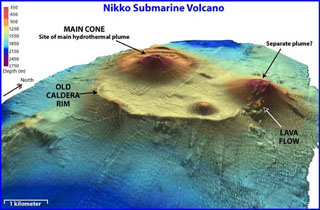Report on Nikko (Japan) — November 1985
Scientific Event Alert Network Bulletin, vol. 10, no. 11 (November 1985)
Managing Editor: Lindsay McClelland.
Nikko (Japan) No water discoloration observed, December 1983-December 1985
Please cite this report as:
Global Volcanism Program, 1985. Report on Nikko (Japan) (McClelland, L., ed.). Scientific Event Alert Network Bulletin, 10:11. Smithsonian Institution. https://doi.org/10.5479/si.GVP.SEAN198511-284132
Nikko
Japan
23.078°N, 142.326°E; summit elev. -392 m
All times are local (unless otherwise noted)
JMSA has continued frequent aerial monitoring of several known submarine volcanoes. Volcanic activity has often been observed at Fukutoku-okanoba during overflights since late 1983, but no water discoloration has been seen at Kasuga, Nikko, or Fukujin.
Geological Summary. Nikko submarine volcano is a massive seamount that rises from nearly 3 km depth to within 392 m of the ocean surface near the N end of the Mariana Volcanic Arc. Two large cones at the basaltic-to-andesitic volcano have been constructed on the NW and NE rims of a roughly 3-km-wide, flat-floored submarine caldera, whose rim is prominently displayed on the southern side, but largely buried on the north. A smaller cone is present on the SE caldera floor. The larger NW cone lies within a partially buried crater and displays hydrothermal activity. Discolored water was observed in July 1979, but none has been observed during semi-regular seasonal reconnaissance flights since then. Hydrothermal venting was documented during a NOAA expedition.
Information Contacts: JMA, Tokyo.

